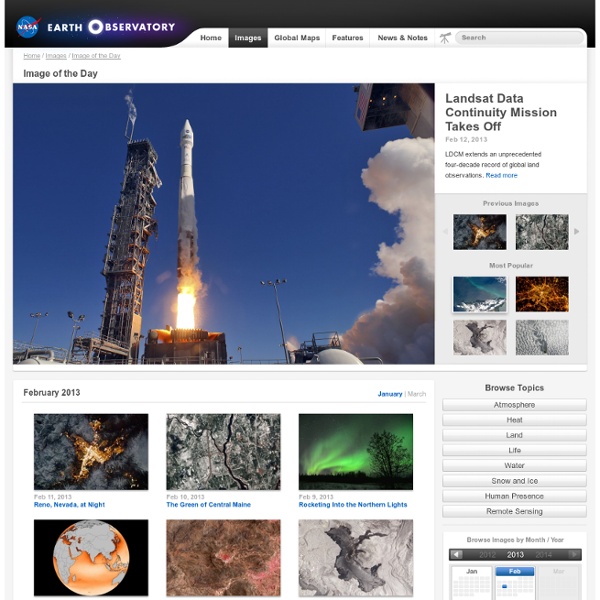



NASA Earth Observatory : Home Stellarium Astronomy Picture of the Day Discover the cosmos! Each day a different image or photograph of our fascinating universe is featured, along with a brief explanation written by a professional astronomer. 2016 April 15 Mercury and Crescent Moon Set Image Credit & Copyright: Miguel Claro (TWAN, Dark Sky Alqueva) Explanation: Innermost planet Mercury and a thin crescent Moon are never found far from the Sun in planet Earth's skies. Tomorrow's picture: Heliopause Electrostatic Rapid Transit System Authors & editors: Robert Nemiroff (MTU) & Jerry Bonnell (UMCP)NASA Official: Phillip Newman Specific rights apply.NASA Web Privacy Policy and Important NoticesA service of:ASD at NASA / GSFC& Michigan Tech.
on reserve Wallpaper Videos See the universe come to life via animations, scientific visualizations, expert commentary, and more. Big News From Mars? Rover Scientists Mum For Now hide captionNASA's Mars rover Curiosity dug up five scoops of sand from a patch nicknamed "Rocknest." A suite of instruments called SAM analyzed Martian soil samples, but the findings have not yet been released. NASA/JPL-Caltech Scientists working on NASA's six-wheeled rover on Mars have a problem. They have some exciting new results from one of the rover's instruments. It's a bind scientists frequently find themselves in, because by their nature, scientists like to share their results. The exciting results are coming from an instrument in the rover called SAM. SAM is a kind of miniature chemistry lab. Grotzinger says they recently put a soil sample in SAM, and the analysis shows something remarkable. Grotzinger can see the pained look on my face as I wait, hoping he'll tell me what the heck he's found, but he's not providing any more information. So why doesn't Grotzinger want to share his exciting news? It wasn't scientific caution that kept Zare from announcing his results.
to reclass The Telescope - Team Hubble Goddard Space Flight Center is home to the Space Telescope Operations Control Center for Hubble. Gathering images from space is more than a "point and shoot" proposition. The Hubble Space Telescope explores our universe 24 hours a day, 365 days a year. Operating and maintaining such a tireless observatory and converting its raw data (digital signals) into images requires considerable effort from the people on the ground. Operating Hubble Hundreds of scientists, engineers, and technicians — at both NASA's Goddard Space Flight Center and the Space Telescope Science Institute (STScI) — bear the collective responsibility for operating the Hubble Space Telescope and for monitoring its health, safety, and performance. Hubble mission operations fall into two categories: Engineering operations, which test and maintain the Hubble spacecraft's overall performance. Hubble's Ground Control Flight Operations All of the Hubble Space Telescope's activities are controlled by people on the ground.
Weekend Feature: NASA-ESA Announce Europa Mission -Search for Life on Jupiter's Water Worlds With input from scientists around the world, American and European scientists working on the potential next new mission to the Jupiter system have announced their joint vision for the Europa Jupiter System Mission to explore "the emergence of habitable worlds around gas giants." The proposed Europa Jupiter System Mission would provide orbiters around two of Jupiter's moons: a NASA orbiter around Europa called the Jupiter Europa Orbiter, and an ESA orbiter around Ganymede called the Jupiter Ganymede Orbiter. "We've reached hands across the Atlantic to define a mission to Jupiter's water worlds," said Bob Pappalardo, the pre-project scientist for the proposed Jupiter Europa Orbiter, who is based at NASA's Jet Propulsion Laboratory. The new reports integrate goals that were being separately developed by NASA and ESA working groups into one unified strategy. Most scientists believe that the subEuropan seas are locked under tens of kilometers of ice. The Daily Galaxy via NASA/JPL